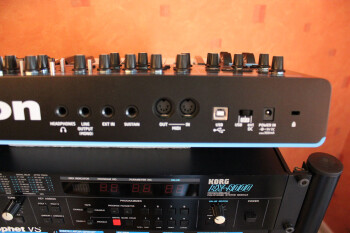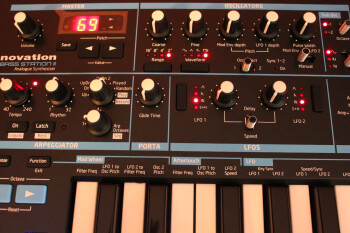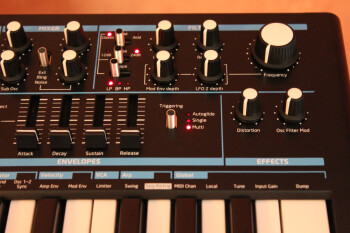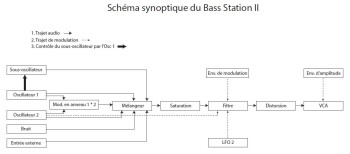Introduced in Frankfurt last spring, the Bass Station II marks the return of Novation to the analog world. Let's find out if the brand was able to retain its know-how.
It was almost 20 years ago that a little known British manufacturer introduced a small analog piano, going against what was the current trend: workstations. Sporting a somewhat geeky look, the Bass Station knew how to conceal its cards — a strong character and an effective sound. It would later find its way onto racks in a powerful 1U format. Later, in 1998, under the guidance of Chris Huggett as technical director (EDP Wasp, OSC Oscar…), Novation took the digital road with the wonderful Supernova, which would become a reference among VA synthesizers; it was the first synth to retain the program effect settings and arpeggios for every part in multitimbral mode. The product range was widely ported to many formats over the next several years, until Novation was bought by Focusrite in 2004. The brand then started focusing on audio interfaces and control surfaces.
Everybody thought their synth era was definitely over. However, at the end of 2012, and against all odds, the Ulranova saw the light of day: monotimbral and accessible, it is a VA synth on steroids. Later on it would also be appear in mini-key format. In early 2012, and with the increasing analog revival in place, Arturia’s MiniBrute opened up a horizon nobody expected. At last a user-friendly, compact and original synth capable of touching the souls of mouse-and-screen junkies! Arturia took everybody by surprise, especially Moog and Korg… After the Sub Phatty and MS20 mini, it’s now the turn of Novation, before Waldorf, to take a new plunge into the analog ocean with the pumped up version of their first-ever synth. So, what are the chances of the Bass Station II against such powerful contenders?
Black and blue
The Bass Station II borrowed several things from its ancestor: the two-octave piano format, the black and blue colors, and the plastic build. The shell is pretty hard this time around, it doesn’t deform easily. All in all, it seems quite solid. The pots are tightly fixed and offer a perfect resistance. There’s not much to say about the envelope switches and faders. The reversing switches seem a bit loose at the shaft, but the switch itself is pretty solid. The build quality of the Bass Station II is very reassuring.
The small top panel is full of controls ─ the more the merrier! On the top left we have the digital section with a three-character LED Display that shows the program number, values, transposition… this is where we can select and save the sounds. The volume knob is also here. They didn’t forget about anything. The synthesis controls are logically distributed in two sections: audio on the top and modulations on the bottom. So, we have first the oscillators, then the mixer and the filters. Next we have the arpeggiator, the LFO and the envelopes. The only two exceptions are the distortion and filter modulation knobs, which are on the lower right corner. Altogether there are no less than 24 knobs (including a huge one for the filter cut-off), 11 selectors, 13 buttons in all forms, and 35 LEDs to simplify our life. The two wheels to the right of the keyboard, one for pitch (spring loaded) and one for modulation, are backlit in electric blue, which gives them a very nice touch! The 25 keys of the keyboard are velocity sensitive and have aftertouch. Plus they feel really nice — hats off!
On the back panel we find all the connections, namely: a mono audio output, a headphone output, a mono audio input (with internally adjustable gain from –10 dB to 60 dB), and a sustain pedal socket (with automatic detection of the polarity when powering on). Everything is on 1/4" TS jacks, except for the headphone output which is, obviously, on TRS. However, the sound is mono. There’s also a MIDI input and an output (notes, CC / NRPN, dumps) and a USB 1.1 port to transfer MIDI data to a host (natively, without drivers) and to supply power to the synth (5V / 0,5A mini). The synth can also be supplied with power via a common external 9V DC / 500 mA PSU, which has a very short cable. A three-position switch allows us to select the appropriate power source (off / PSU / USB). The USB port doesn’t make the Bass Station II a MIDI/USB interface open to the outside world. Finally, we also have a Kensigton security slot but there’s no CV/Gate connection in sight ─ in our opinion, the only flaw in an otherwise perfect analog environment.
Usability and design
Given the number of controls on the top panel, are we close to perfection? Almost… and here comes our first criticism regarding usability: some controls are shared by different functions in several sections. That’s the case of the two oscillators, which can be accessed alternatively via a switch. The LFOs share the same controls for delay and speed, while the envelopes have only four shared faders: our only consolation is that we can edit them separately or together, thanks to a selector. All of this doesn’t make things easier live. Jumps in values are guaranteed, especially considering that the controls only respond in this way (there’s no threshold or relative mode). Second usability flaw: additional controls are accessible by holding down the Function button and pressing a keyboard key. That’s the case of the physical controllers (wheels, velocity, pressure) and even of the oscillator sync, a function that is far from being secondary, and which could have easily found a place in the oscillators section on the top panel…
As soon as we edit a “continuous” parameter, its value is immediately reflected on the display: two LEDs indicate the position of the current value in relation to the stored value. Nice one. The two buttons to transpose per octave increments (-5/+4) and the one to transpose directly in semitones are also very practical. To recall one of the 128 programs in the memory we only have two scroll buttons. It’s definitely not ideal to go straight to our goal, even if the scrolling speeds up when we hold down the buttons… When saving an edited program we can listen to the destination patch before overwriting it. However, the synth has no Edit / Compare / Recall buttons, like other preset synths that have a more generous control panel. As soon as we power on the Bass Station II it goes automatically to program 1, regardless of where we left it before turning it off. To close this short usability chapter, let’s just add that together with the external PSU and the USB cable, a short product manual (about 20 pages) is supplied with the product. The full manual is available for download on Novation’s website…
Bass jumping
During the private demo we had in Frankfurt (and also from the first demos available online), our impression was that of a synth with a distorted, compressed and aggressive sound. People who like this type of sound can rest assured the Bass Station II knows its trade. Particularly due to the different overdrive/distortion options available and the limiter in the output. But those who like rounder, warmer and fatter sounds can also relax: the Bass Station II can produce more vintage-like sounds, like only analog synths know how to do it. We focused more on the latter during this review to give you another take on the matter, given what is already available on the web. All examples were made using the 70 factory default sounds with more or less retouches… do remember that all 128 memories can be overwritten.
In comparison with a vintage VCO synth, we have a lot more stability (unless the LFOs are set on the pitch), because the Bass Station II, just like its ancestors, uses perfectly calibrated DCOs. The basses are the preferred domain of the small Novation, who would’ve guessed: fat, round, mute, aggressive, acid, punchy ─ it can do almost anything The velocity and aftertouch allow for and increased expressiveness. You can feel the power of the multimode filter, the distressing resonance of the standard mode, the coloration of the Acid mode, the pre-filter distortion, the speed of the envelopes… The lead sounds of the Bass Station II do not disappoint either: at times subtle, at time biting, at times heavy. It is very agile in this range. We also liked some percussion sounds among the very comprehensive array of options.

- Bass Station II 1audio Bass 1 00:41
- Bass Station II 1audio Bass 2 00:22
- Bass Station II 1audio Bass 3 00:20
- Bass Station II 1audio Bass 4 00:41
- Bass Station II 1audio Bass 5 00:35
- Bass Station II 1audio Bass 6 01:18
- Bass Station II 1audio Percus 3 pistes 00:18
Hybrid sounds
The Bass Station II generates 100% digitally controlled (tuning, modulations) analog audio signals (oscillators – filter – amp). Everything starts with the oscillators. We have two DCOs and one sub oscillator (linked to DCO1) at our disposal to start with the right foot. Each DCO has a range of 2 to 16 feet, with a pitch that can be adjusted over a range of ± one octave (in 1/10-tone steps) or even finer, over a range of ± one semitone (in 1/100-tone steps). We have four non-cumulative waveforms per DCO: sine, triangle, sawtooth, and variable width pulse. The latter can be adjusted manually (5% to 95% of the cycle) or modulated by LFO2 or the modulation envelope. The pitch can be modulated by LFO1 and the modulation envelope (even at the same time if we want). All modulations are bi-polar, some of them have a resolution of 256 values if need be. Both DCOs can be synced and are ring modulated. There is also a time-variable portamento available.
What’s more, we have a sub DCO too. It works one or two octaves below DCO1 and provides sine and square waves, as well as fixed pulse (25% approx.). Plus, we have a white noise generator to have some fun and the eventual audio signal connected to the appropriate input. All this can be mixed thanks to a 6–1 mixer: DCO1, DCO2, Sub, Ring Mod, Noise, and external signal. In the mixer section, the main sources have their own dedicated pot, while the secondary sources share a three-position selector and one pot.
Multiple filtering
After coming out of the mixer, the signal goes through a multimode filter with variable slope. In fact, there are two different filters which, unfortunately, cannot work at the same time. The Classic filter is more versatile, because it works in low-pass, bandpass and high-pass mode using two or four poles. The filtering is bright and the resonance very accentuated, not really stable, giving rise to self-oscillation. The design of the Acid filter was inspired by a four-pole diode-ladder low-pass circuit from the 80’s, apparently that of the TB-303. The frequency response is duller and the resonance purer, limited just below self-oscillation. Not very acidic, but musical and well-controlled, at least as long as we do not overdrive it at the input…
Where some add a Brute Factor or a Multidrive, the Bass Station II offers a pre-filter distortion (overdrive) and a post-filter distortion. Combined with the Acid mode, the overdrive provides supplementary resonances: on a sawtooth wave we can create a square wave on top. Ideal for acid basses… at last, we got there! The cut-off frequency can be modulated by the modulation envelope, LFO2 (bi-polar modulations) and DCO2 (original!). But, where did they put the key follow? Well, there isn’t any, it’s fixed to 100%, darn! A good point: the “critical” continuous values have an increased resolution to avoid a step-like impression. For the cutoff frequency we have 256 values ─ it’s almost perfect. After the filter, the signal goes to the VCA. There it will experience a level-compensated distortion, to get a little dirty just before going out, as well as a simple limiter to avoid breaking the speakers when the super distorted and hyper resonant filter starts oscillating…
Clever modulations
To make the sound move, the Bass Station II offers two LFOs and two envelopes. The LFOs are identical and assigned to the modulations. The parameters that are directly accessible are the typical ones: waveform (triangle, sawtooth, square, sample & hold), speed (0 Hz to 190 Hz, which means it goes all the way to audible levels, cool!) and delay. Every LFO has other parameters that can be accessed via the Function button: tempo sync to an internal / MIDI clock, a free or set cycle, and even a Slew effect to modify the shape of the waveform (it’s well worth it!). LFO1 can also modify the pitch of every DCO independently; the overall modulation degree can also be controlled via the wheel or pressure. LFO2 is assigned to the pulse width modulation of each DCO (independent amounts) and to the frequency of the filter. Once again, we can control the filter modulation degree by LFO2 via the wheel.
A little less specified than the LFOs, the two envelopes are ADSR and they are fast enough to create percussion sounds with transients. The attack can vary from 0 to 5 seconds, while the release can be of up to 10 seconds long. We can choose three modes to control the way each envelope, and the portamento, is triggered: single, multi and autoglide. Finally, there are more modulation options available via the Function button: the wheel can vary the filter cut-off frequency but also the pitch of DCO2 (a good option for syncs and to control the filter modulation via DCO2); we can control the cut-off frequency of LFO2 via key pressure; and we can use velocity to modify every envelope and, thus, the pitch, filter or volume — it’s just perfect!
Arpeggios and sequences
The Bass Station II wouldn’t be a Novation without a programmable arpeggiator. It has a very comprehensive module that can be synced to an internal or MIDI clock, plus it has a dedicated tempo knob. We have direct access to 32 more or less rhythmically complex motifs (arp sequences). The arpeggiator can act on one to four octaves according to six modes: up, down, alternating (x2), and played or random order. We can even add some swing.
Even better, there’s a 32-note sequencer that can be programmed step by step. We have four user memories at our disposal that can be saved and recalled regardless of the program, and which are retained in the memory even after we turn the synth off — thank you! Every step can be a note or a silence, and the notes can be tied or played in a legato fashion. All sequences can be triggered and transposed on the fly with the keyboard. The arp sequence selector allows 32 time signature variations — clever. If only Novation had thought of providing some extra tracks for modulations…

- Bass Station II 1audio Old lead 1 00:10
- Bass Station II 1audio Old lead 2 00:17
- Bass Station II 1audio Old lead 3 00:18
- Bass Station II 1audio Pad mono 00:22
- Bass Station II 1audio Sync 1 00:12
- Bass Station II 1audio Sync 2 00:22
- Bass Station II 1audio Voice 00:22
Conclusion
The Bass Station II is an undeniable accomplishment. It has almost everything to please us: it’s financially accessible, easy to use and offers nice and diverse sounds. We like especially the oscillators (which can be widely modulated), the multi-mode filter, the different distortions, the clever modulations and the arpeggiator / sequencer. However, we do regret a couple of limitations that are directly related to its size: the controls grouped together and the tiny keyboard (even if velocity sensitive and with aftertouch). Even more regrettable are the lack of CV/Gate connections and, particularly, the absence of a programmable key follow on the filter. Anyway, the Bass Station II is a quality choice for people looking for a compact, mono analog synth that is not too expensive but provides character and heaps of tricks. It has earned our 2013 Best Value For Money Award.
Download the audio files (WAV format)





















